Thought-provoking work written by Margie Adam chronicling the Women’s Music movement and the activism surrounding it.
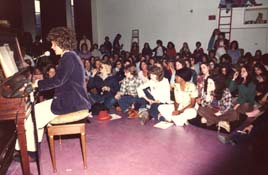
More recently, I found myself backstage at the rally site for the National Gay/Lesbian/Bi March on Washington preparing to perform for one million people. I was completely unnerved by the mixture of celebrity energy swirling around backstage along with the reality of ‘history in the making.” Then I looked around and had a moment of clarity. I was surrounded by a crew of women I recognized from Women’s Music festivals all over the country–the same women I had been working with for years. These were the people who were producing this incredible event for a million people live and countless millions watching on tv. I was instantly on solid ground.
I was born and raised as a singer/songwriter/performer and feminist organizer in the Women’s Music movement of the l970s.. My life has been forever changed by singing and playing music with other strong women singer/songwriters and musicians. My molecular structure is forever encoded with the feminist vision of Women’s Music.
What is Women’s Music?
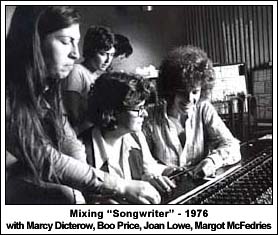 There are three questions I have been repeatedly asked over the last 25 years. First, what is Women’s Music? It is music that affirms and empowers women. Who makes Women’s Music? Women. Who’s it for? Anyone…but especially women and pro-feminist men. Your answers to these questions may not be the same as mine. It’s the 90s and there is a lot of room in here.
There are three questions I have been repeatedly asked over the last 25 years. First, what is Women’s Music? It is music that affirms and empowers women. Who makes Women’s Music? Women. Who’s it for? Anyone…but especially women and pro-feminist men. Your answers to these questions may not be the same as mine. It’s the 90s and there is a lot of room in here.
I would never have become a performer let alone an organizer had it not been for the second wave of the women’s liberation movement. I was reeled in by the passion and audacity of a gang of women who were riveted on the goal of changing the world for women– through music. I still believe in the power of women writing, singing, playing, producing, distributing and broadcasting strong women-centered and inclusive, life-affirming music and culture to save this world.
Music of Conscience versus Protest Music
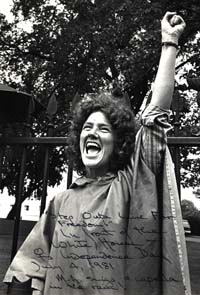
It’s easy to see this truth in action. Look at the difference in descriptive labeling that attends Sting, Bruce Springsteen and Peter Gabriel in contrast to those of us in Women’s Music. All three of these men are known to be singer/songwriters with deeply held beliefs concerning the issues of the day-they have involved their music in the real world. They are considered artists of conscience. Critics admire and respect their music because it has content and politics. However, when women songwriters express their involvement in the world from an empowered point of view, the music is minimized, marginalized or dismissively categorized as ‘protest music.”
Do We Need a Feminist Activist Community Today?
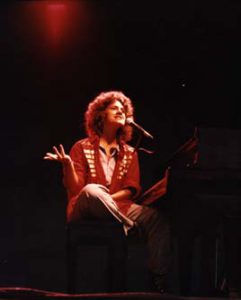
- Violence against women in the US is increasing. There are more rapes, murders, assaults, more domestic violence, incest, than ever.
- 80 % of the refugees in the world are women and girls.
- 3800 animal shelters in the US – only 1800 battered women’s shelters.
- ERA has still not been ratified by the minimum 38 states in this country.
- A women’s right to control her reproductive functions is still subject to the control of the federal and state governments.
- There are still disproportionately small numbers of women in State legislatures and US Congress and Senate.
- Of all the money given by all the foundations in the US, only 5 % is given to projects and organizations for women and girls.
- Women are still paid significantly less for the same jobs men do.
- Many women are sexually harassed on the street and at work every day.
- The media continues to inundate us with images of women and girls that are demeaning and woman-hating.
Every Movement Has Its Music
Clearly the work of the women’s liberation movement is not done. We still need a culture that reflects and supports this work and the women who make this movement.
Just as every significant movement for social change has had its music–the civil rights, union and anti-war movements-we must have ours.
Many of us found a community when we came out as lesbians. For straight feminists, the feminist community was the first place there was acknowledgement of women’s independence and strength. When we talk about a women’s community, I believe we are talking about a place where feminist activism and women’s culture are the principles of unity which hold us together.
Why Did We Create Women’s Music Network in the First Place?
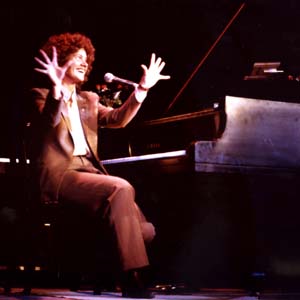 In order to take control of how women were defined and presented in music, we started record labels and production/distribution companies and encouraged women technicians and women in media. Women’s Music has always operated on several levels:
In order to take control of how women were defined and presented in music, we started record labels and production/distribution companies and encouraged women technicians and women in media. Women’s Music has always operated on several levels:
- The vision of feminist values in our relationships with each other and in the world as expressed in music/lyrics and performance.
- The network of independent women’s businesses, organizations and individuals interdependent and supporting feminist culture.
- The industry of record companies, production companies and artists.
- The organizing tool using music, artists and performance to inspire and reinforce empowerment and activism in women and pro-feminist men.
Women’s Music as a Vision
I believe women are a people. We have a culture. We have a language. And yet women have no land of our own, no safe space in this woman-hating country and world.. Concerts and festivals of Women’s Music and culture are as close as we come to having our own country. Here we can say: we are together…we are safe.
Women’s Music as an Organizing Tool
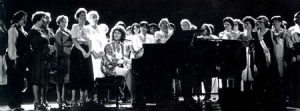
ERA ratification deadline July 1, 1982[/caption]Women’s Music and concerts/festivals of our culture are a lifeline to women who want to change, who want to come out, who want to take power in their own lives, who want to experience a women-centered community.
Some women feel Women’s Music exists today only as a historical artifact…. ie. that was then, this is now. They feel that the audience that needed Women’s Music and gatherings of women’s culture has grown out of that need, has found other satisfying pursuits, etc. Is this true?
Do We Need Women’s Music Today?
After all, we have Melissa , kd, Tracy Chapman, Mary-Chapin Carpenter,The Indigo Girls, ani diFranco. Maybe we don’t need Women’s Music? Is our job done because kd and Melissa are out there? I don’t think so.
While it is extremely positive that these gifted women are successful headliners in the mainstream music industry, our work is not done. If we declare victory now and quit, we diminish our ability to define ourselves We have only to look at MTV to see that negative and demeaning images of women are alive and still viable in the marketplace.
By accepting the view that Women’s Music is only a historical artifact, we may be backlashing ourselves. I suggest there is no expiration date on the women’s liberation movement, on Women’s Music or on the women’s community.
Certainly the style and the forms have changed and need to change as we evolve, but not the substance. Our charge is to make what we know accessible to a new generation of independent women artists and producers.
The Good News…
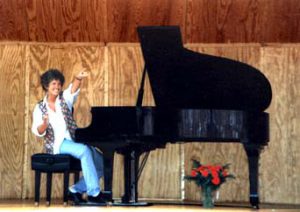
- to maintain control over their music and image
- because they can get the music out without waiting for an invitation to record with the ‘majors”. There are now too many female recording engineers to count.
Reality check: Carole King has just founded her own record label.
Women’s Music is more diverse in terms of musical styles and disenfranchised communities of women than ever, just check out the line-ups at National or Michigan festivals.
Lesbians continue to be the major contributors and supporters of the women’s music network and movement. We can be proud of our history of accomplishment and our endurance.
The Bad News…
The corporate music industry scrapes the creme of Women’s Music artists/recordings and discards the deep catalog of Women’s Music. Women’s music gets less airplay than ten years ago-women’s music has become women IN music–less or no feminist content The corporate music industry has absorbed non-commercial radio, the single best avenue for airplay.
The integration of women’s music into folk/blues/new age and pop categories has submerged women’s music once again. Try searching for ‘Women’s Music” through one of the big, online music stores. Most artists identified with Women’s Music will be listed under the ‘folk” category, even those of us who write jazz, r & b, or classical music with no lyrics.
Reviews are the lifeline of most musicians. There are far fewer women’s newspapers today so there is almost no coverage of our concerts. Mainstream and even so-called alternative presses never consistently reviewed our events and even today almost always ignore our performances unless the music is attached to a political event deemed to be significant. And then, the music and performance are seldom reviewed.
Visionaries in Women’s Music can take credit for
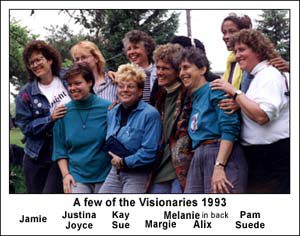
- introducing the issue of accessibility to all of America.
- being a training ground and mentoring system for women technicians, performers, producers and distributors
- building alternative distribution and production networks
- creating, performing,producing, recording and distributing a huge body of music which empowers and honors women.
Whenever and wherever this music is played, it continues to stand as a direct challenge to woman-hating culture.
The Future of Women’s Music
Passion, audacity and activism are still the fuel of this community and its culture. Why do women who identify with Women’s Music keep doing it? Not for the $$. It’s too hard. We have always operated with another currency of exchange and it is acknowledgment. We share the stage, we share skills/contacts. We are passionate partners. Supporting Women’s Music means supporting artists, producers, distributors, technicians, women’s media AND the audience. As an audience, we must continue to see ourselves as agents of change, not passive consumers.
We are a network of independent women’s businesses, part of an underground feminist economy as self-sustaining businesses.
Feminist activism continues to inform and fuel those of us who believe women are the agents of change that will save this world.
There is a continued need for community, an entry point for women seeking a safe space to come out, to experience woman-loving energy.
What is Real?
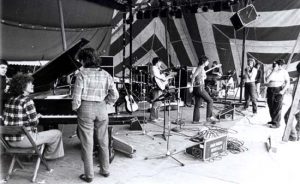
What we are doing in women’s music and women’s culture is real. Our radio programs are real. Our magazines and journals and newpapers are real.
The on-going challenge is to support women’s culture, nurture the women who create it and pass this feminist vision on to the world who desparately needs it in order to save itself.